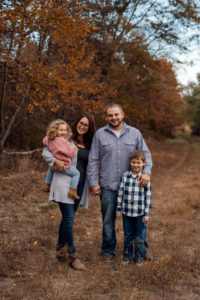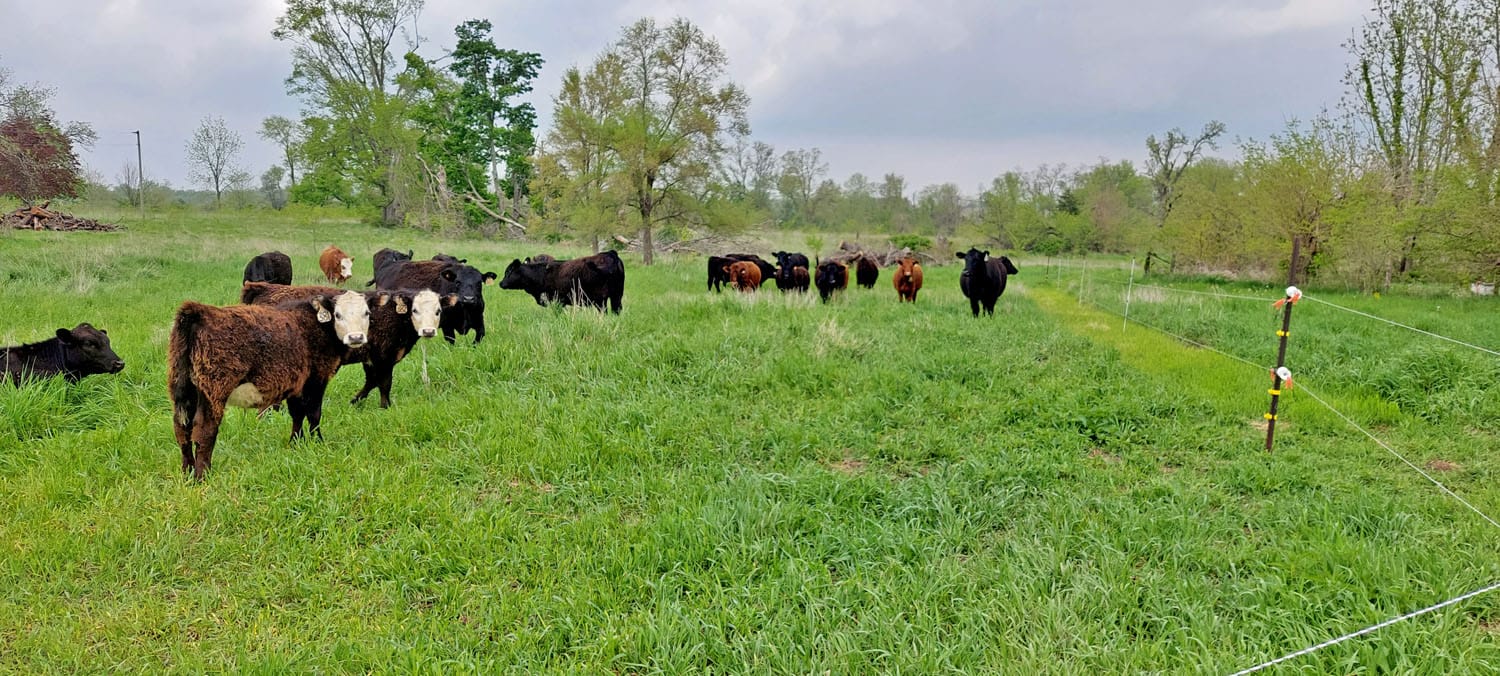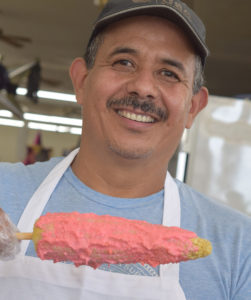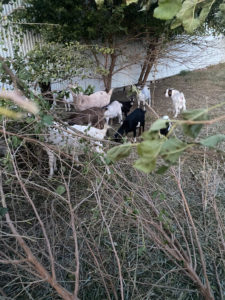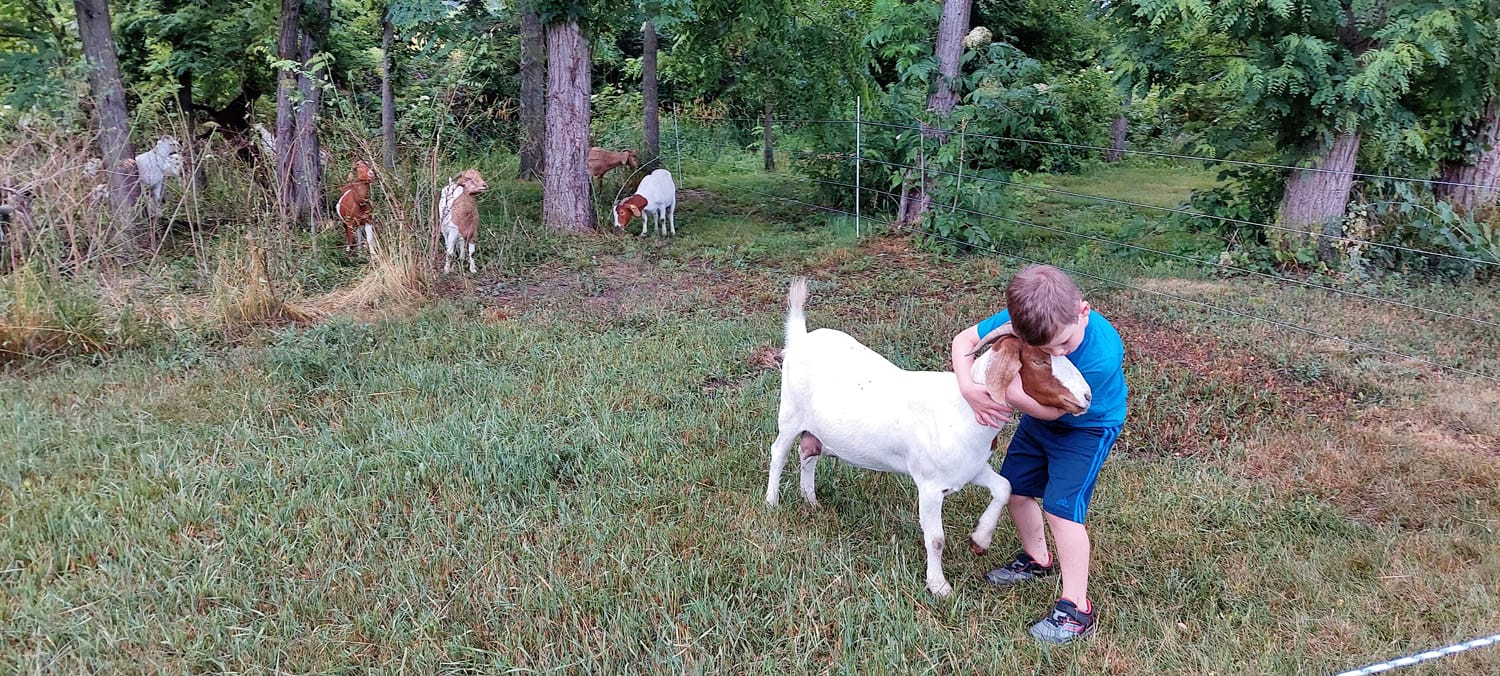The Roots of Community
PFI’s grazing cost-share is getting livestock on the land while helping farmers build new connections
The sky was grey and the temperature had dropped overnight. It was officially the first day of winter and the weather made sure we knew.
We stopped by a field to see where the cows had been. They had grazed and been moved to greener pastures. Now, only the brittle and windswept stalks of lambsquarters remained, and the soft cowpies dotting the field as a parting contribution from the cattle.
Within sight of her farm, close enough that her son watched the cattle while waiting for the morning school bus, Laura Keniston of Night and Day Ranch near Alburnett, Iowa, explained what it meant to see her cattle graze this neighboring land, otherwise unavailable, using portable fencing she was able to purchase through Practical Farmers’ grazing infrastructure cost-share program.
“We’ve established relationships with neighbors,” Laura says. “The relationships are the only way all this works.”
In 2022, Laura was part of the inaugural group of farmers to access funds through PFI’s grazing infrastructure cost-share pilot program. Now in its second year, the program helps farmers achieve their unique grazing goals by reducing expenses for grazing infrastructure.
Graziers have responded enthusiastically – nearly 150 applied for the limited funds. Margaret Chamas, PFI’s livestock viability manager, says the cost-share has helped farmers improve grazing management through investments in portable, flexible infrastructure, like mobile watering and fencing. More broadly, however, the program is feeding PFI’s mission to equip farmers to build resilient farms and communities.
“Cost-share is a way to support farmers’ investments in their operations and help them make better decisions as they increase their grazing infrastructure,” she says. But she has also noticed other benefits. “The program is generating more curiosity, excitement and relationships among participants.”
Maintaining Dreams
A few hours away, in northwest Iowa, Silvino Morelos raises goats, chickens and horses on his farm outside of Storm Lake.
Surrounded by blackberry bushes (the fruit of which he donates to a local baker), the farm is an old livestock auction site. It’s been an undertaking to transform the space into a working farm. Silvino has removed buildings to make pasture space, and repurposed materials for feeders and shelters for the goats.
He too enrolled in PFI’s grazing infrastructure cost-share and used the funds he received to build a waterline. He’s also looking at buying portable fencing to rotate the goats.
“We’ve been working really hard on setting up our goat operation and making everything a bit more streamlined,” Silvino says, with optimistic pride, during an interview conducted in Spanish. “And honestly, I’m finally seeing the light at the end, and seeing how this will be overall more economically friendly to my businesses.”
To make the farm viable, he aims to sell meat and dairy products from his storefront in downtown Storm Lake. “I wouldn’t have time to do what I love if it wasn’t part of my job, so this is me doing both.” In his roles as farmer and small-business owner, Silvino is a leader in his community who helps to build bridges and make resources more accessible.
“In my experience, the folks I’ve talked to are hesitant to believe there are organizations that have genuine intentions to help the Latino community,” says Valeria Cano Camacho, PFI’s senior Latino engagement coordinator. “So it takes community leaders like Silvino to shovel a path of trust that others are more likely to follow. Reputations via word of mouth are huge.”
The relationships Silvino has built – ranging from farmers to shop customers – are critical to his success. Growing up in Mexico, he learned farming, butchering and cheesemaking from his grandfather.
Now in Iowa for the past eight years, Silvino has found he’s able to rely on his new network for ideas and insights, and to help troubleshoot questions that arise. As he provides meat for celebrations like quinceañera and weddings, Silvino is sharing what he’s learned and hearing new ideas from his community.
“Especially with goats, I feel like there is a stronger sense of community due to the lack of vet visits available for small ruminants,” he says. “So a lot of folks end up peer-mentoring each other.” He adds, “I see it as the only way to survive and maintain our dreams.”

Silvino stands in front of his Storm Lake business, Valentina’s Meat Market (photo courtesy of Sheila Brummer/IPR News).
A Win-Win
Back at Night and Day Ranch, Laura looks at the pile of step-in posts and spools of polywire fencing she bought with her husband, Mike, using grazing infrastructure cost-share funds. These portable fencing components had just been pulled from neighboring properties for the season and wrapped up for storage and reuse. The livestock are home for the winter and only a fraction of fence is needed to graze cornstalks in the field.
“I knew you were going to ask me how much fencing there was, and I just don’t remember,” Laura says with a laugh. “It’s a lot.” All that new fencing let the Kenistons divide their animals and graze based on more specific needs. Now, they have up to four separate groups grazing at a time based on species and seasonal birthing. It takes more coordinating, but the relationships they’ve built allow that flexibility.
Their first partnership was with Laura’s uncle, who farms her family’s row-crop ground. He didn’t take much convincing. “Fertilizer prices skyrocketed last summer,” she says. “So we said, ‘Hey, instead of driving manure back and forth across the field wasting fuel and time, why don’t we let the cattle eat up some of the corn on the ground and spread the manure for you?’ It was a win-win.”
Laura also connected with Sean Stokes and Drew Erickson at the Rodale Institute Midwest Organic Center, which owns land across the street from her farm. The pair are exploring ways to integrate livestock as part of their experiments with small grains. One of the questions they want to answer is what role the cattle play in these integrated systems. “Is it just manure that matters (for soil health), or is there more to it?”
Sean says. “Is it the actual grazing, urine and hoof action? Or does simply spreading manure give the same effect?” Thanks to the portable fencing, Laura is able to take part in the research project. For Sean and Drew, having neighbors with cattle and fencing made the partnership easy.
Laura and Mike formed a similar partnership with Indian Creek Nature Center. The center, based in Cedar Rapids, owns the Etzel Sugar Grove Farm, which is adjacent to the Rodale land Laura’s grazing. The Kenistons are now helping to graze permanent pasture at the farm that had sat unused for decades and become almost impassable.
Without healthy disturbance from livestock, black locust trees took over, choking out everything else. Locust thorns punctured tires while fallen fence tangled around legs. Seeking to rehabilitate the pastures, the center started managing the brush through mechanical removal. Thanks again to the new portable fence, Laura and Mike are able to assist the effort by rotationally grazing their cattle on the land. The work continues, but the pasture is noticeably clearer.
“Not all landowners are going to have livestock, and not all livestock producers will have adequate land for grazing,” Laura says. “It’s nice to try out these relationships and show that it’s going to work. You just need good communication to make sure everyone is achieving their goals.”
At each farm we visited where Laura and Mike grazed livestock in 2023, signs of the community they’ve built were silently on display: Mike helping a neighbor finish insulating a new house before the cold set in, Christmas gifts exchanged before the holidays. Silent, daily acts of coming together, of care. Relationships rooted in grazing.

